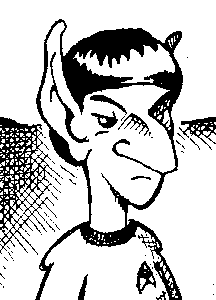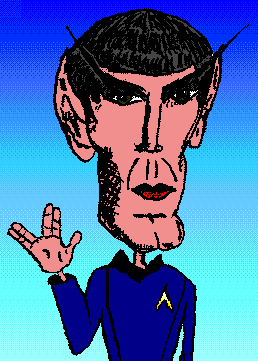 |
| Cartoon by Christopher Smith. |
Stomp Tokyo Groks Spock's Talk
by Chris Holland
Although I'd heard that Leonard Nimoy was giving a talk at the University of South Florida's Tampa campus, it wasn't until my wife called to say she had tickets that I gave it much serious thought. What the hell, the tickets were free. We went, dragging Scott (the co-creator of Stomp Tokyo) with us to see the guy with the pointy ears talk about his life and Star Trek.
The Special Events Center had been converted into a Trek convention for the night; the lobby was now a dealers' room, with every sci-fi gimgaw and bauble conceivable available for your hard-earned cash. The dealers looked glum; I don't think anyone was expecting this kind of market to be there, and so no one had brought enough loose cash to wheel and deal. I'd blown any "extra" money I had on Star Wars toys in the preceding weeks, so I wasn't even tempted.
The 45 minutes before Nimoy appeared were filled with the sound of Star Trek's greatest theme songs, and an atrocious trivia contest held by the U.S.S. Victorious, St. Petersburg's own Trek fan club. These guys had held contests at sci-fi movie premieres before, so I knew what to expect. The questions were OK, but there was no system for figuring out who had raised their hand first, especially in an audience of more than 500 people. And of course, no one thought to read the answer back over the sound system once the prize for that question had been one, leaving those of us who didn't know the trivia saying "What? What was the name of Spock's dog on the cartoon series?" It was pretty poorly organized, and I've written too much about it already.

Cartoon by Christopher Smith.
The audience had its share of hard-core trekkies. The 10-year old boy who sat behind me had his copy of I Am Spock ready to be autographed, and of course the Victorious people were in uniform. At every mention of the words "Star Trek," half the audience burst into spontaneous applause. And this was before Nimoy ever hit the stage.
Nimoy's first joke was therefore quite appropriate. He walked to the podium to a standing ovation and held his hands up in the Vulcan salute. "You're very emotional," he chided the audience.
Wearing a sport jacket and a button-down shirt open at the neck, Nimoy half-leaned on the podium as he spoke. He talked about his early acting career and shared a couple of anecdotes about his early fame, including his (accidental) billing as "Leonard Nimsy" during the Hollywood Thanksgiving Day Parade. "Bill Shatner still calls me Nimsy," he said.
Eventually, he wound his way around to Trek. Nimoy attributed Trek's endurance to "the hopeful nature of the stories" and "the intelligence of the show." Mostly, though, he said that the "dedication and work of talented people" had ensured the show's success over different series and generations. Acting, he said, is valuable because it tries to impart values. According to Nimoy, Star Trek's popularity is also due largely to the fact that the actors and creators of the series do their best to bring honor to their work.
"That's one of the things I like best about this business," he said. Describing Hollywood as a "meritocracy" may have been taking it a bit far, but his recitation of a key speech about honor from Henry V did illustrate his point. Yes, ladies and gents, Spock does Shakespeare. To further illustrate that show business is a great business, Nimoy brought clips from Star Trek IV -- blooper clips.
"Captain, I have hail storms!" flubs Nichelle Nichols in one of the first clips. (She was supposed to say "whale song.") Other clips included scenes from San Francisco, with Shatner and Nimoy turning the "correct change" joke into a running dialogue, and DeForrest Kelly (as Dr. McCoy) continuously misquoting his line from Hamlet.
Then, suddenly, we were into clips of the aquarium scenes from the same movie. Nimoy spent half an hour explaining the various special effects shots and different locations required to film these scenes correctly. Here's how it breaks down:
The aquarium itself (called the "Cetacean Institute" in the film) is the Monterey Bay aquarium in northern California. I've been there, courtesy of my scuba-diving wife who grew up in the area. The aquarium is definitely worth the trip, even without the Trek novelty. Most of the interior and exterior sequences were done on location. The whale enclosure is actually a protected grotto for orphaned or recovering sea lions and seals; the water filling the grotto and outer wall were digitally added in post-production.
The shots from the whale tank looking out onto the outer patio area (with the whales swimming in between the camera and the tour group) was done on a mockup of the patio at Paramount Studios in Los Angeles. A water tank was placed in front of the mockup set and hydraulic whale fin- and tail-models were used to create the illusion of whales swimming.
When the tour group moves downstairs to see the whales from the side view of the tank (underwater), the shots from in front of the group, looking towards Shatner and the nun, were done again in Monterey. The group is actually looking at a brick wall (and darn it, I have to admit that Shatner has his moments of pretty good acting -- case in point his "reactions" to Spock swimming in the tank).
In the same scene, the camera moves behind the tour group to see the window into the tank. This shot was taken at the Industrial Light and Magic studio in San Rafael, CA. The actors stood in of a blue screen and the 'tank' was added later. The underwater sequences with Nimoy/Spock in the tank were done in yet another location, this time with mock whales in a tank at NASA's El Segundo weightlessness training facility.
All of this was capped off by the fact that all of the underwater sequences which featured the whales alone (without people) were done with whale models only 3-4 feet long. These were built by ILM as well, and were so realistic that even a sea lion who swam with it was curious. All in all, this look at the special effects for Star Trek IV was (with apologies) "fascinating."
With the clips out of the way, Nimoy began to wrap up his prepared comments, bringing us up-to-date with new personal and Trek projects. The biggest news is that the Sci-Fi channel has bought the exclusive TV rights to Star Trek (the original TV series) and will air it in its entirety, starting in 1998. Nimoy (and presumably some others) will host the shows, presenting anecdotes during commercial breaks.

Nimoy has also formed a "books on tape" company with some other Trek stars of past and present to read science fiction classics, including H.G. Wells' The Time Machine. Simon & Schuster will begin distributing that line this year.
Nimoy then began to take questions, which ranged wildly in topic.
On his favorite episodes:
Nimoy claimed that "it's a selfish thing;" meaning that his favorite episodes are Spock-centric. "Amok Time," and "City on the Edge of Forever" were both mentioned, and this led Nimoy down the how-did-the-Vulcan-salute-get-started story path. For those who don't know, Nimoy "invented" the salute, or rather stole it from a Jewish ceremonial blessing. "It's become a big thing," he said, holding up his hands in a double-salute. As the cameras captured this Spockian moment, he added, "See? When I do it, flashbulbs go off. ... It's magic."
On future movies which might feature members of the original crew:
"Are the original crew members done with the movies? I think the question is, is Paramount finished with US?" Paramount has his number, said Nimoy, but he hasn't gotten any calls.
On Gene Roddenberry:
"Roddenberry was a complex man," said Nimoy. He added that he and Roddenberry had a difficult father/son relationship, and that Nimoy sometimes felt like he wasn't performing to Gene's expectations because "Dad wouldn't throw his arms around me and say 'You're Great.'" Nimoy said this with a smile that indicated he had gotten over this long ago.
On Harlan Ellison's recent griping about the final product of the episode "City on the Edge of Forever," which differed from Ellison's original screenplay:
Nimoy said that he and Ellison have spent many hours together, talking about such things. In Nimoy's opinion, the "idea and the script came off quite well." He also felt that "the show did justice to his work."
Nimoy wrapped up with a story about his early career, during which he made money as a cab driver. One of his fares was John F. Kennedy, then a senator in Nimoy's home state of Massachusetts. When he heard about (the then-unknown) Nimoy's difficulties in getting work, Kennedy told him to remember that "There's always room for one more good one." Nimoy said those words sustained him for a long time.